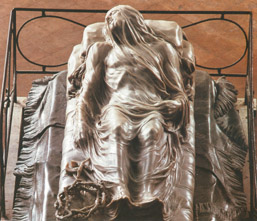|
|
Apartments in Florence, Perugia, Rome, Sorrento and Positano |




|
|
|
|
- You are in: Home » musei » SANSEVERO CHAPEL - Naples -
SANSEVERO CHAPEL - Naples -

According to the historian Cesare d'Engenio (1642), this chapel was probably first built around 1590.
At this time Giovan Francesco di Sangro, Duke of Torremaggiore, had just had a serious illness and he
had the little chapel built to the Virgin of Mercy in his garden in sign of gratitude for his recovery.
In 1608 Alessandro di Sangro, son of Giovan Francesco, had the chapel enlarged "because it was not able
to hold all the people who came to see the endless miracles performed there". The chapel also became a burial
place for members of the family, in addition to being a place of worship.
Little is known about the chapel in the XVII century, because the building as it is now dates back to
Raimondo di Sangro's alterations carried out in the XVIII century, which were so extensive as to change
the previous decor. The name of the architect who originally directed the works is unknown, but he probably
followed the wishes of his client, as the simplicity of the rectangular plan without a real apse, and the
large number of statues and decorative items would lead one to suppose that there was no specific plan.
There was probably much of the typical XVII century love for decoration in the chapel, as Pompeo Samelli
remarks in 1697 that the chapel is "pleasingly enriched with very fine work in marble, and with statues of
many famous members of the family and their epitaphs".
The most interesting period in the history of the chapel starts around 1742. Prince Raimondo di Sangro,
(1710-1771) who personally supervised the alterations, perfectly embodied the spirit of the century where he lived.
A particularly skilful soldier, a scientist and alchemist, his insatiable curiosity caused him to become a legend in his time.
In 1749, the artist Francesco Maria Russo completed the great fresco on the ceiling and the trompe-l'oeil
decoration with medallions in tones of green of the six Saints in the family. Russo also designed the statue
of Raimondo di Sangro which stands at the entrance to the underground cavea.
In the middle of the presbytery is the extremely large and theatrical work by Francesco Celebrano, the
Deposition, made like a "painting in marble", and on both sides are Chastity by Antonio Corradini (left),
and Disenchantment by Francesco Queirolo (right). The former was made when the sculptor, who was famous
all over Europe, came to Naples at an advanced age - he was, in fact, to die the following year. It has been
said that this work, notable for its sensuality, is more suitable for an art-gallery than a church, although
it is supposed to represent the great virtue of Cecilia Gaetani, the Prince's mother; the blend of holy and profane
thought, was the most remarkable artistic feature of this period.
The second sculpture, by the Genoan Francesco Queirolo, is real virtuos work: he fashioned a net thrown over
a male figure trying to get out of it, and this must have been an incredibly difficult task.
The last sculpture is certainly the finest and has become the simbol of the chapel - the Veiled Christ by
Giuseppe Sanmartino. Until the recent discovery of the original sketch for this sculpture (made in 1753), it
was attributed to a sketch by Corradini. It is now known that Sanmartino, a Neapolitan sculptor, was commissioned
to make this piece and that it was to be placed in the cavea, illuminated from above by the "eternal lamps" invented
by the Prince and not where it is placed now - in the centre of the nave. With the original position in mind, Sanmartino
studies the effects of light on the intricate folds of the shroud covering the body, lying on the cushions. In this
superb play of light and shadow, death is no longer seen as a painful separation from life, but as a poetic moment.
This poetry originated from the sculptor's amazing technical skill, which can be seen in many of the works made
during his long career. This sculpture is one of his early ones, and the languid atmosphere of pre-Romanticism
can be strongly felt here. So striking was this piece, that another famous sculptor - Antonio Canova - wanted
to buy it during a visit to Naples, but fortunately for Naples that purchase was never made.
museums archive
|
|
|
|
|
|
| TOP DESTINATIONS
|
| Adria Coast, Aeolian Islands, Alessandria, Altopiano Delle Rocche, Amalfi Coast, Aosta, Assisi, Asti, Bari, Brescia, Capo Vaticano, Capri, Catanzaro, Chianti, Cilento, Cinque Terre, Coast Of Marche, Conero Coast, Dolomites, Egadi Islands, Elba, Florence, Garda Lake, Gargano, Ischia, Italian Riviera, Lake Como , Langhe Piedmont, Lecce, Lucca, Lunigiana, Macerata, Mantova, Maremma Tuscany, Monferrato, Montepulciano, Naples, Perugia, Pesaro Urbino, Pisa, Pistoia, Positano, Prato, Procida, Riviera Of Palms, Rome, Salento Coast, Salerno, San Gimignano, Sardinia, Sicily, Siena, Sorrento, Terni, Tiber Valley Of Tuscany, Treviso, Turin, Val Gandino, Veneto, Venice, Viterbo |
|
|




